
Reference Publication: Parker, D.S., J.K. Sonne, J.R. Sherwin, and N. Moyer, November 2000. "Comparative Evaluation of the Impact of Roofing Systems on Residential Cooling Energy Demand." Contract Report FSEC-CR-1220-00, Florida Solar Energy Center, Cocoa, FL. Disclaimer: The views and opinions expressed in this article are solely those of the authors and are not intended to represent the views and opinions of the Florida Solar Energy Center. |
Executive Summary:
Comparative
Evaluation of the Impact of Roofing Systems
on Residential Cooling Energy
Demand in Florida
Danny
S. Parker, Jeffery K. Sonne, John
R. Sherwin and Neil Moyer
Florida
Solar Energy Center (FSEC)
FSEC-CR-1220-00
Executive Summary (Also see the Full Paper, News Release, Photos and PDF Version)
 Roof
and attic thermal performance exert a powerful influence on cooling energy
use in Florida homes. Unshaded residential roofs are heated by solar radiation
causing high afternoon attic air temperatures. The large influence on cooling
is due to increased ceiling heat transfer as well as heat gains to the
duct systems which are typically located in the attic space (Figure E-1).
Roof
and attic thermal performance exert a powerful influence on cooling energy
use in Florida homes. Unshaded residential roofs are heated by solar radiation
causing high afternoon attic air temperatures. The large influence on cooling
is due to increased ceiling heat transfer as well as heat gains to the
duct systems which are typically located in the attic space (Figure E-1).
The Florida Power and Light Company and the Florida Solar Energy Center instrumented six side-by-side Habitat homes in Ft. Myers, Florida with identical floor plans and orientation, R-19 ceiling insulation, but with different roofing systems designed to reduce attic heat gain. A seventh house had an unvented attic with insulation on the underside of the roof deck rather than the ceiling:
- (RGS) Standard dark shingles (control home)
- (RWS) Light colored shingles
- (RSL) Standard dark shingles with sealed attic and R-19 roof deck insulation
- (RWB) White "Barrel" S-tile roof
- (RWF) White flat tile roof
- (RTB) Terra cotta S-tile roof
- (RWM) White metal roof
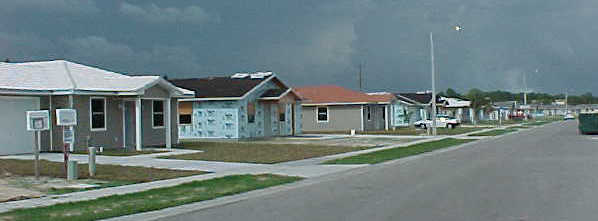
Street scene showing the three closest homes (from left: white "barrel"
s-tile (RWB), terra cotta s-tile (RTB) and white metal (RWM)).
All seven houses were completed by June 26th, 2000 with extensive testing to assure the buildings were similar. Each home was monitored simultaneously from July 8th - 31st in an unoccupied state.
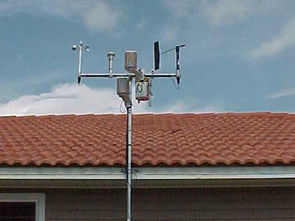
Project Meterological Station
Building thermal conditions and air conditioning power were obtained on a 15-minute basis. Each of the examined alternative constructions exhibited superior performance to dark shingles. Figure E-2 plots the maximum daily air temperature to the maximum recorded at mid-attic in each construction. Figure E-3 shows the average daily attic air temperature profile.

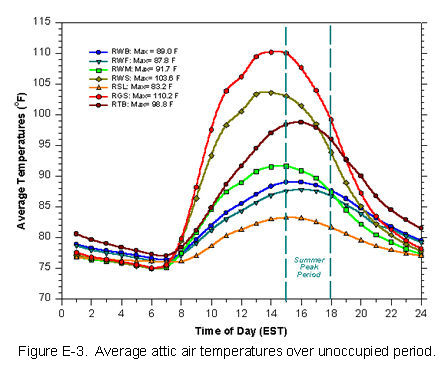
The maximum attic temperature during the peak summer hour is 40 F greater than ambient air temperature in the control home while no greater than ambient with highly reflective roofing systems. Light colored shingles and terra cotta roofs show temperatures in between. Table E-1 summarizes the metered data from the unoccupied period and Figure E-4 shows the variation in space cooling load profiles in the test homes.
Table E-1. Cooling Performance During Unoccupied Period July 8th - 31st, 2000
| Site | Total kWh |
Savings kWh |
Saved Percent |
Demand kW |
Savings kW |
Saved Percent |
| RGS | 17.03 |
---- |
---- |
1.63 |
---- |
---- |
| RWS | 15.29 |
1.74 |
10.2% |
1.44 |
0.19 |
11.80% |
| RSL | 14.73 |
2.30 |
13.5% |
1.63 |
0.01 |
0.30% |
| RTB | 16.02 |
1.01 |
5.9% |
1.57 |
0.06 |
3.70% |
| RWB | 13.32 |
3.71 |
21.8% |
1.07 |
0.56 |
34.20% |
| RWF | 13.20 |
3.83 |
22.5% |
1.02 |
0.61 |
37.50% |
| RWM | 12.03 |
5.00 |
29.4% |
0.98 |
0.65 |
39.70% |
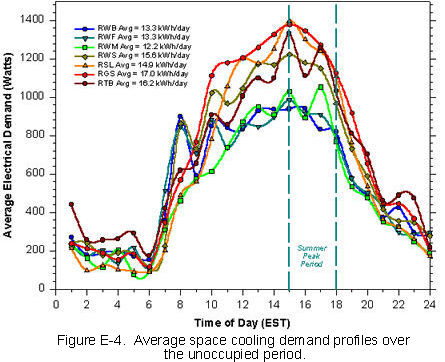
The above results are for the 1,144 square foot homes in the study. Since savings largely scale with ceiling area, the kWh and kW values should be normalized by the applicable ratio. For instance, typical FPL homes of 1,770 square feet would have estimated absolute savings 55% greater than above. Also, normalizations were made for slightly different thermostat set points and the measured performance of individual AC units.
Table E-2. Summary of Normalized Savings and
Demand Reductions from Regression Estimates
| Case Description | Cooling Savings |
Peak Demand Reduction |
||
kWh |
Percent* |
kW |
Percent* |
|
| RGS(Control) | --- |
--- |
--- |
--- |
| RWS (White Shingle) | 300 |
4% |
0.48 |
17% |
| RSL (Sealed Attic) | 620 |
9% |
0.13 |
5% |
| RTB (Terra Cotta Tile) | 180 |
3% |
0.36 |
13% |
| RWB (White S-Tile) | 1,380 |
20% |
0.92 |
32% |
| RWF (White Flat Tile) | 1,200 |
17% |
0.98 |
34% |
| RWM (White Metal) | 1,610 |
23% |
0.79 |
28% |
detached South Florida homes detailed in Appendix H.
Additional monitoring took place over a month long period with the homes occupied, but the thermostat set points were kept constant. Although average cooling energy use rose by 36%, analysis indicated no decrease to savings or demand reduction from the highly reflective roofing systems. The added heat gains from appliances and people increase cooling system run-time causing the duct system to run for longer periods to exchange heat from the often hot attic space.
 White s-tile roof home |
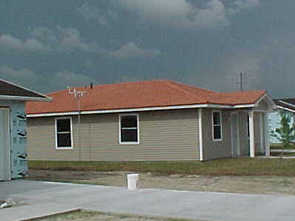 Terra cotta s-tile roof home |
|||
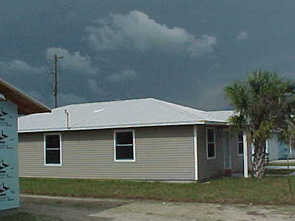 |
||||
White metal roof home |
||||
The results in Tables E-1 and E-2, show essentially two classes of performance: white shingles, terra cotta tile and sealed attic construction which produce energy savings of 200 - 600 kWh/yr and demand reductions of 0.05 - 0.5 kW. Highly reflective roof systems produce energy savings of 1,000 - 1,600 kWh with demand reductions of 0.8 - 1.0 kW. A separate analysis of the data using a special version of the DOE-2.1E computer simulation verified the magnitude of the measured energy and demand reductions.
In summary, this evaluation strongly confirms the energy-saving benefits of using more reflective roofing systems in Florida. Selection of colors with higher solar reflectance will result in tangible cooling energy savings for customers. This is particularly true for roofing materials such as tile and metal, which are currently available with solar reflectances of 65%-75% range. The selection of reflective roofing systems represents one of the most significant energy-saving options available to homeowners and builders. Such systems also strongly reduce the cooling demand during utility coincident peak periods and may be among the most effective methods for controlling demand.
Acknowledgements
This study was funded by the Florida Power & Light Company in partnership with the U.S. Department of Energy, Office of Building Technology under the auspices of the Building America Industrialized Housing Partnership.
(Also see the Full Paper, News Release and Photos)
